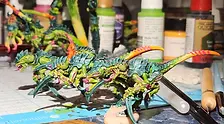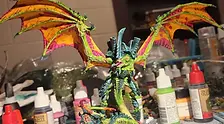top of page
OBICEPH
The advanced 3D course at Ringling contains a project focused on organic modeling and sculpting. Sculpting was a method I had done before, and fell in love with it. Being given the opportunity to advance my skills in this area was a highlight of the program.
CONCEPT
An existing hobby of mine is creating, modifying, assembling, and painting miniatures, and at the time of the project, Warhammer 40,000 was the miniatures game that captured my interest most. In any franchise I participate in the fandom of, one of my favorite things to do is create custom content to tailor it for my own preferences even more. A sculpting project seemed like the perfect time to exercise that habit, and create a new unit for my favorite faction.

Image Credit: Games Workshop; White Dwarf Issue 495




A few of my painted Tyranid models, most of which have been customized through a combination of fire to bend the plastic, with a knife and clay to make more extreme changes to the poses.
The Tyranids' motivations are mostly unknown, and there aren't any recognizable characters within the faction, as they are all subject to a hive mind that directs its countless puppets to consume everything they can find. Each organism is entirely organic, equipped with biological weaponry alone, aside from the psychic capabilities of a select few. An army consisting solely of what are essentially souped up space dinosaurs is right up my alley, but several of my favorite models are meant to be disposable cannon fodder that get in the way while bigger monsters score points. I wanted to create something that could escort my weak units into advantageous positions, so taking inspiration from the ant genus Cephalotes, some of whose soldiers have a wide, flat skull they use to block the entrances of their nests when intruders attempt to make entry. I named my own walking shield wall the Obiceph, from the Latin obice (barrier) and Greek kephalo (head).


The idea for this design had existed previously to the project, but it needed refinement to be as strong as possible. The original illustration to the left felt too empty and lightweight, so the sketch on the right attempts to create a bulkier, more powerful looking beast. The final model would use a blend of both to create a more satisfactory product.
SCULPTING
Once the plan for the Obiceph was set, the next step was to begin creating it in Cinema 4D.

Games Workshop's models are highly detailed, and so the Obiceph had to follow suit, and provide lots of surfaces for paint to interact with, making a person 3D printing and assembling it feel like a master painter.
FINAL
The final animation, inspired by the opening credits of Pacific Rim, uses light and shadow to emphasize the detail of the Obiceph model with an ominous track in the background to reflect the monster's role as a cog in an all consuming biological machine.

bottom of page